| 1 | Copperhead |
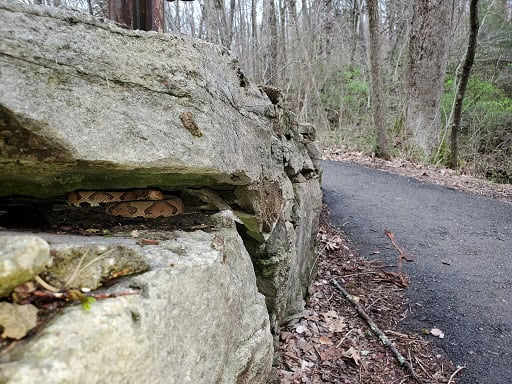
The copperhead is one of the USA’s most feared snakes, particularly among dog walkers. They’re generally a woodland creature, blending in with thick beds of leaves with their beige-orange hourglass markings. But copperheads are also highly attuned to rock formations. Dark limestone rock crevices are their favourite spot to hibernate during the winter, sometimes alongside other snakes, and they can be found lurking stealthily in shadowy crevices during the active season too. A rock wall within a forest in the eastern USA is a likely place to hear a sudden serpent hiss followed by an explosive serpent lunge.
Cottonmouths average at 60-95cm, with an all time record of 134.6cm. Despite their reputation, they’re generally calm when humans walk by, but can explode with anger if touched in any way. They will make a sudden heavy-bodied pounce, and deliver a cytotoxic venom which is capable of causing severe skin deformities and agonising swelling, though not usually death. Once they’re satisfied, they’ll return to their rock crack lair and brood for a while over the day’s events.
In the eastern USA, copperheads have even been found sharing a dark rock crevice with other species like black racers and eastern ratsnakes, forming a communal hibernacula. The ultimate copperhead hangout would be a rocky gap which has become covered with fallen leaves – this would allow them to deploy their usual camouflage, and to enjoy the shelter of a dark crevice.
| 2 | Adder |

The adder (Vipera berus) is a master of exploiting its environment, and taking shelter in dark rock cracks is one example. This species might be the most widespread venomous snake in the world, and it’s certainly the one with the largest west-east span. Adders range from Great Britain in the far west to the heart of Mongolia in the east. They’re also the most northerly snake, occupying the Arctic areas of northern Norway.
Adders rarely appear in urban areas, or even suburbs. But you can find them in heathland, woodland, forests, animal burrows, and dark crevices between rock formations, where they can poke their head out to startle passers-by, particularly if their signature blood red eyes are visible. A sudden strike to your ankle is a definite risk in adder country, particularly if it’s a slope filled with jumbled rock formations.
Adders are ordinarily slow-moving, but no slouch when it comes to sudden strikes. Their venom lacks neurotoxins, speciaising in haemorrhagins and cytotoxins instead. Deaths are relatively rare, with the last UK death occurring in 1975. Still, if you’re at the foot of a rock field in Germany, and are looking at a sign saying “warning – venomous snakes”, it might be wisest to find another route.
| 3 | Eastern milk snake |

The milk snake (Lampropeltis triangulum) is an uber-common species worldwide, ranging from southern Canada to Ecuador. In the US they can be found almost anywhere east of the Rocky mountains. Several weird myths surround them, such as a skill to coil around a cow’s udder and squeeze it rhythmically to extract the milk inside (hence their name). Something that isn’t invented is the power to hide in dark rock crevices that a human would barely be able to reach his arm into. The image above shows a milk snake in Tennessee, tucked away neatly from harm.
Milk snakes are confirmed prey for several large mammals, including red foxes and striped skunks. If they choose their shadowy rock crevice carefully enough, then there’s no way these hungry predators will be able to thrust their snout in, even in the full manic throes of a feeding frenzy.
The milk snake is a non-venomous constrictor, which preys primarily on reptilian foods such as skinks and lizard eggs. They reach a maximum length of 132.1cm, and have 24 subspecies worldwide, of which some are probably independent species which haven’t been genetically analysed yet. The scarlet kingsnake of Florida (Lampropeltis elapdoides) has already been split off, having once been the 25th subspecies.
| 4 | Black-necked spitting cobra |
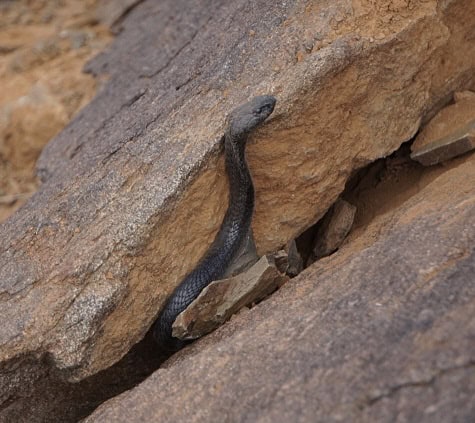
An 100-200cm African snake which no sane person would ever want to meet. The black-necked spitting cobra isn’t found in lush jungles teeming with life, but they’re found in most other habitats, and dry rocky slopes are one of their favourite places to lurk. A tall cliff with a jumbled mass of boulders at its foot is a likely home for this cobra, or perhaps several cobras. The shadowy rock crevice next door might have another, while a lone dislodged boulder with a crack down the middle could even host a pair of cobras, which simultaneously poke their heads out to greet you.
Black-necked spitting cobras inhabit a huge swathe of central Africa, including Nigeria, Tanzania, Kenya and Uganda. As well as rock cracks, they’re commonly found in towns, agricultural fields, woodlands, and on open plains. They can often be seen scanning the horizon alertly, as though examining the state of their kingdom.
This snake is a grave threat to anyone that lives near it. The black-necked spitting cobra (Naja nigricollis) is dangerously venomous, with a mixture of neurotoxins and flesh-rotting cytotoxins, plus the ability to split large venom globules directly into your eyes, which can blind victims for several days. Then there’s the sheer horror of seeing a long black snake slithering out of a rock formation, which doubles when you see it perform its signature neck flare.
| 5 | Rosy boa |
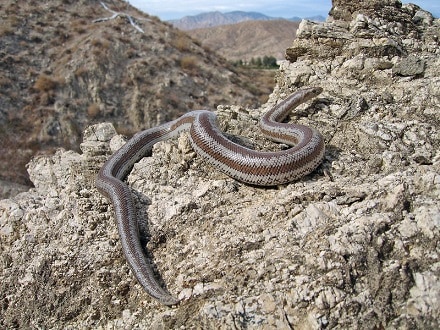
A non-venomous constricting snake found in rocky areas of Baja California, southern Arizona and far southern California. The desert rosy boa (Lichanura trivirgata) is one of the most docile snakes on Earth, making them popular in captivity. In the wild, they prey mainly on mammals such as pack rats, kangaroo rats and rabbits.
Rosy boas live in rock cracks within deserts, and spend days and days there without moving. While the desert boa is naturally shy, they still like to be on top of things, aware of their surroundings. A rock crack where they can just poke their head out is the perfect solution. These are the perfect places to wait for mammals to pass, which they suddenly pounce on. Though they have many needle-like teeth, desert rosy boas are extremely slow-moving (except when pouncing), meaning that a cosy rock crack is essential for their survival.
In winter while hibernating, they spend weeks and weeks in these dark crevices without moving. Their love of dark rock cracks make this harmless snake very difficult to find. The exception is spring, when rosy boa males suddenly become more interested in females, and are much more likely to be seen on the surface.
The rosy boa’s ultimate habitats are granite outcrops, and they’re only found in desert areas without rocks extremely occasionally. Find a spot on a desert outcrop, sit still over many long hours, and you may just get a glimpse of a rosy boa slithering between jumbled rock formations, attempting to follow scent particles. If intimidated by humans, this species will curl up into a ball with its brain at the centre, hoping desperately that they leave.
| 6 | Nose-horned viper |
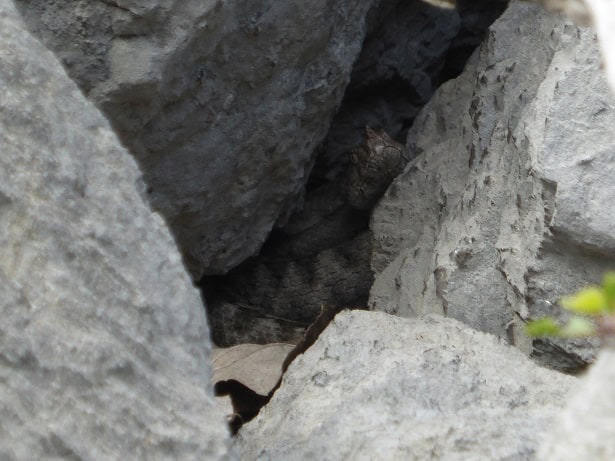
Greece’s most common venomous snake. The nose horned-viper (Vipera ammodytes) is part of the large Vipera family, which also includes Britain’s adder. They’re differentiated by their sharp namesake horn, as well as their stony grey colours, which evolved for one reason: to blend in with rocks.
Nose-horned vipers average at 65cm long, and mainly inhabit southeast Europe, including Greece, Slovenia and Albania. Instead of forests, they have a strong preference for rocky slopes frequented by hikers. Nose-horned vipers don’t just slither through these rugged landscapes, but hide in the rocks themselves. Shadowy fissures in rock walls are equally acceptable, and mother nose-horned vipers will even lay their babies inside these crevices, giving them a safe haven to develop.
Vipera ammodytes envenomates several hundred Greeks per year, and was responsible for two deaths in Croatia in the 1990s. This isn’t a snake of sunny plains; it much prefers dark, tight spaces, where it can calmly calculate its next move. Snakes might be feared, yet they value peace and security just as much as we do. Actually, that’s only true for some snakes. The likes of Boulenger’s forest racers zip around the forest completely exposed, with no concern for their own safety. But nose-horned vipers are wiser than average, and hide in shadowy rock cracks at night, only venturing into the open when they need to hunt.
| 7 | Southwestern speckled rattlesnake |
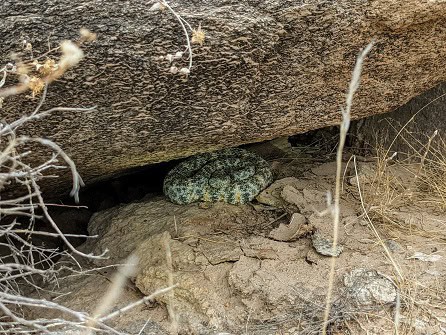
This moderately lethal rattlesnake is found in western Arizona, southern California, Nevada, and the northern areas of Baja California (Mexico). The likes of tiger rattlesnakes hang around on desert flats with plenty of cacti, but the southwestern speckled rattlesnake differentiates itself by a love of steep rocky slopes. They even vary their colour based on the exact type of rock, from pink to grey to beige.
Southwestern speckled rattelsnakes (Crotalus pyrrhus) reach a record length of 132cm and have caused no confirmed human deaths on record. Disappearing into rocky cracks is one simple survival strategy they have at their disposal.
This rattlesnake can vanish into cracks which are inaccessible for thicker animals, allowing them to rest and digest in comfort while plotting the next day’s activities. They can then leave the narrow entrance the next day, and begin the hard snake work of flecking their tongue constantly for scent particles. Southwestern speckled rattlesnakes have also been found in groups in rocky crevices, ranging from 2 to 10 individuals.
Southwestern speckled rattlesnakes derive around 80% of their meals from mammals, such as antelope squirrels, pocket mice and Bryant’s woodrats. The rocky crevices they lurk in are a perfect place to pounce on these oblivious creatures from. The rock rattlesnake is another member with a constant tendency to lurk in rocky cracks; this species lives further east, inhabiting rugged desert slopes of southeast Arizona, New Mexico and western Texas.
| 8 | Eastern kingsnake |
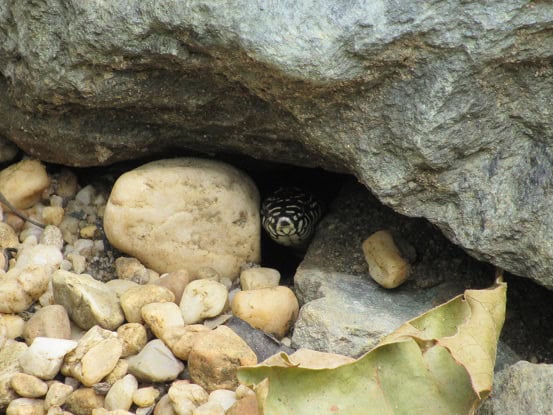
Part of the same Lampropeltis family as the milk snake. Eastern kingsnakes (Lampropeltis getula) are extremely flexible in their diet, greedily hoovering up mammals, lizards and fellow snakes such as the ring-neck snake. They’re extremely flexible in their habitats too, appearing in grassland, woodlands, hills, the borders of agricultural fields. Places they can shelter include mammal burrows and of course, shadowy rock cracks, where they can lurk and watch the world go by in peace, all while plotting their next move.
Eastern kingsnakes don’t have any particular association with dark rock crevices, unlike the southwestern speckled rattlesnake. Yet they’re such convenient hideaways that the eastern kingsnake will still lurk in them, being a practical and flexible snake.
As you read this, several thousand common kingsnakes are lurking in dark rock crevices in the eastern United States, digesting meals in peace, sleeping or perhaps debating whether to enter hibernating early. This species is non-venomous, and acquires its prey using neither ambush nor venom, preferring to roam the landscape continuously while flecking their tongue nonstop for scents. Like all kingsnakes, they’re extremely powerful and efficient constrictors, though they lack any ability to harm humans. Over 150cm is considered large for the common kingsnake, and the record was 208.3cm.
| 9 | Red diamond rattlesnake |
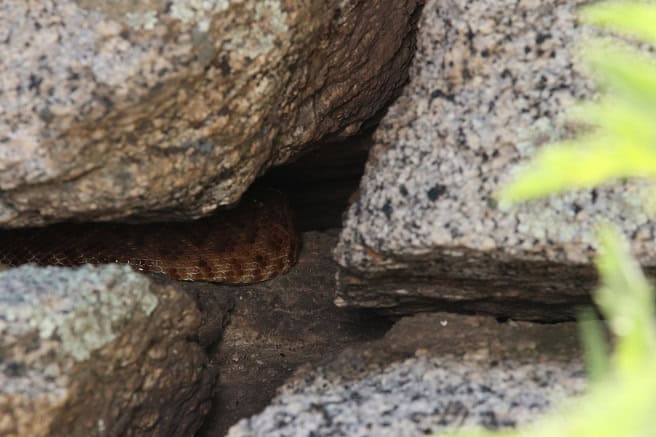
Another rattlesnake with a close connection to rocky areas with deserts, and another one which disappears into the darkness of rock crevices, both to hibernate during winter, and for simple rest during the active season.
Red diamond rattlesnakes (Crotalus ruber) are found only in southwest California in the USA, but they’re extremely abundant where they do appear. Rugged desert foothills are their main habitat, and they can be recognised by their consistent red body, overlaid with dark diamond shaped markings, and a black-white tail.
Red diamond rattlesnakes eat a diet comprised of 90% mammals, including deer mice and kangaroo rats. They’re preyed on themselves by coachwhips and California kingsnakes. In their harsh desert realms, there’s few places to shelter, so they’ve been pushed into dark rock cracks out of simple practicality.
Though it hasn’t been studied, there’s a good chance that they return to the same exact crevice each day. The smooth snake of England can stay in the same root bed hollow for years, while black mambas also have permanent bases. It makes sense for the red diamond rattlesnake to return to a comfortable rock crack they know inch by inch. They know the diameter of the entrance, which predators can’t fit into, and they know which mammals wander past on their well-trodden daily routes. They might even be guided back each day by their own scent. Red diamond rattlesnakes average at 100-140cm and peak at 162.5cm (so far).
| 10 | Cottonmouth |
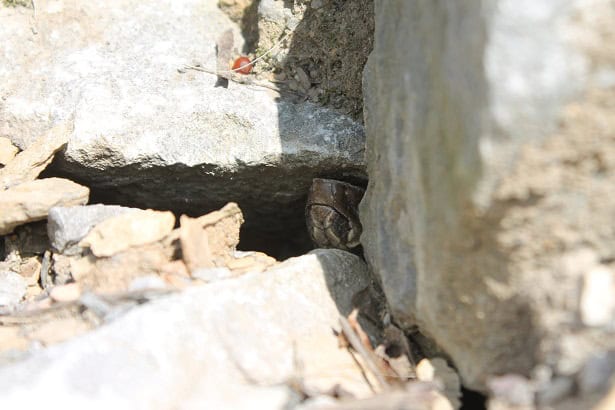
The cottonmouth is the main reason why when hunting for kingsnakes or milk snakes, you should never mindlessly peer into a dark rock crevice within a forest.
It’s true that cottonmouths (Agkistrodon piscovidous) are way more aquatic than their copperhead cousin. They dwell in murky swamps hunting fish, and dodging the greedy jaws of alligators and whooping herons. They’re infamous for leaping from branches onto fishermen’s heads (this is probably a myth). However, they still venture to dry land commonly, and when seeking refuge, a rock crevice is one of their favourite spots. Like the copperhead, upland rock crevices away from their home swamps are a top place for cottonmouths to spend 3 months or more in hibernation.
Ever dropped your keys and had them fall into a dark rock crack? There could be a cottonmouth waiting inside. There could even be a copperhead or a cottonmouth waiting at the same time, as venomous snakes regularly share hibernacula without coming into conflict.
The image above was taken in Cheatham County, Tennessee, yet there are likely cottonmouths poking their faces out of dark rock chambers all over the country, unknown to people. It’s possible that while walking past a rocky outcrop near a swamp, you’ll see a brief glimpse of a cunning serpent face, with vertical slits for pupils, only to do a double take and see nothing there. If this happens, then we strongly advise ignoring your curiosity and walking onwards.
